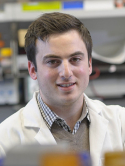Modeling biological and genetic diversity in upper tract urothelial carcinoma with patient derived xenografts Journal Article
| Authors: | Kim, K.; Hu, W.; Audenet, F.; Almassi, N.; Hanrahan, A. J.; Murray, K.; Bagrodia, A.; Wong, N.; Clinton, T. N.; Dason, S.; Mohan, V.; Jebiwott, S.; Nagar, K.; Gao, J.; Penson, A.; Hughes, C.; Gordon, B.; Chen, Z.; Dong, Y.; Watson, P. A.; Alvim, R.; Elzein, A.; Gao, S. P.; Cocco, E.; Santin, A. D.; Ostrovnaya, I.; Hsieh, J. J.; Sagi, I.; Pietzak, E. J.; Hakimi, A. A.; Rosenberg, J. E.; Iyer, G.; Vargas, H. A.; Scaltriti, M.; Al-Ahmadie, H.; Solit, D. B.; Coleman, J. A. |
| Article Title: | Modeling biological and genetic diversity in upper tract urothelial carcinoma with patient derived xenografts |
| Abstract: | Treatment paradigms for patients with upper tract urothelial carcinoma (UTUC) are typically extrapolated from studies of bladder cancer despite their distinct clinical and molecular characteristics. The advancement of UTUC research is hampered by the lack of disease-specific models. Here, we report the establishment of patient derived xenograft (PDX) and cell line models that reflect the genomic and biological heterogeneity of the human disease. Models demonstrate high genomic concordance with the corresponding patient tumors, with invasive tumors more likely to successfully engraft. Treatment of PDX models with chemotherapy recapitulates responses observed in patients. Analysis of a HER2 S310F-mutant PDX suggests that an antibody drug conjugate targeting HER2 would have superior efficacy versus selective HER2 kinase inhibitors. In sum, the biological and phenotypic concordance between patient and PDXs suggest that these models could facilitate studies of intrinsic and acquired resistance and the development of personalized medicine strategies for UTUC patients. © 2020, The Author(s). |
| Keywords: | protein kinase b; cancer chemotherapy; clinical article; controlled study; aged; unclassified drug; somatic mutation; clinical trial; histopathology; cisplatin; nonhuman; gemcitabine; chemotherapy; animal tissue; carboplatin; metastasis; multiple cycle treatment; tumor volume; epidermal growth factor receptor 2; animal experiment; animal model; genetic variability; genetic variation; tumor biopsy; tumor xenograft; fibroblast growth factor receptor 3; protein p53; histology; carcinogenesis; cell heterogeneity; rna; oncogene; tumor suppressor gene; dimethyl sulfoxide; biological activity; ischemia; western blotting; phosphatidylinositol 3,4,5 trisphosphate 3 phosphatase; carcinogenicity; immunoblotting; genomics; recurrent disease; liver resection; cell count; cyclin dependent kinase inhibitor 2a; tumor growth; cytokeratin 14; cytokeratin 5; tumor; hermes antigen; genetic screening; drug sensitivity; transitional cell carcinoma; transcriptome; antibody; model; neratinib; rna sequence; tumor engraftment; immunocompromised patient; phylogeny; modeling; tumor microenvironment; drug; cyclin dependent kinase inhibitor 2b; germline mutation; cyclic amp responsive element binding protein binding protein; estimated glomerular filtration rate; cell component; cancer; human; male; female; article; cytokeratin 6b; rna sequencing; whole exome sequencing; positron emission tomography-computed tomography; dna mismatch repair protein msh2; trastuzumab deruxtecan; 2 tert butylquinone; at rich interaction domain 1a; bone marrow stromal antigen 2; cytokeratin 6a; ginsenoside rb 1; lysine demethylase 6a; lysine methyltransferase 2d; harmonics generation; photon microscopy |
| Journal Title: | Nature Communications |
| Volume: | 11 |
| ISSN: | 2041-1723 |
| Publisher: | Nature Publishing Group |
| Date Published: | 2020-04-24 |
| Start Page: | 1975 |
| Language: | English |
| DOI: | 10.1038/s41467-020-15885-7 |
| PUBMED: | 32332851 |
| PROVIDER: | scopus |
| PMCID: | PMC7181640 |
| DOI/URL: | |
| Notes: | Article -- Export Date: 1 June 2020 -- Source: Scopus |
Altmetric
Citation Impact
BMJ Impact Analytics
MSK Authors
-
 352
352Coleman -
 201
201Ostrovnaya -
 786
786Solit -
 359
359Iyer -
 26
26Dong -
 60
60Hu -
 26
26Watson -
 33
33Hanrahan -
 47
47Gao -
 267
267Vargas Alvarez -
 669
669Al-Ahmadie -
 132
132Gao -
 525
525Rosenberg -
 331
331Hakimi -
 170
170Scaltriti -
 25
25Bagrodia -
 16
16Murray -
 45
45Kim -
 54
54Penson -
 120
120Pietzak -
 9
9Jebiwott -
 31
31Cocco -
 16
16Audenet -
 15
15Dason -
 26
26Almassi -
 26
26Alvim -
 15
15Nagar -
 4
4Hughes -
 25
25Wong -
 19
19Clinton -
 2
2Gordon -
 12
12Chen -
 3
3Elzein
Related MSK Work



